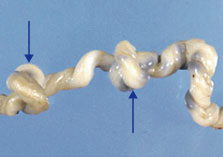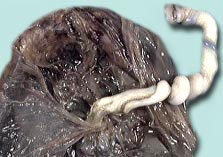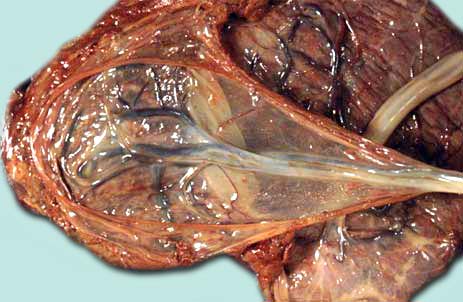|

|
|
|
Role and abnormalities of the umbilical cord
|
|
|
|
The umbilical cord's main function lies in the transport of blood to and from the placenta.
|
|
|
|
Pathologies of the umbilical cord
|
|
|
The normal length of the umbilical cord lies between 50 and 60 cm with a diameter of 1.5 cm. It can be either too short (seldom) or too long (more prevalent) and can thus wind itself around the neck or the extremities of the fetus or even form knots. Moreover, during birth, a part of the umbilical cord can get trapped in the birth canal. One calls this umbilical cord prolapse.
|
|
|
| Umbilical cord knots |
|
Insertion of the cord at two places |
|
Legend |

|
|

|
|
In the left picture two knots (arrows) are visible.
In the one on the right, a bifurcation of the umbilical vessels with insertion locations on the placenta at two places is seen.
|
|
Furthermore, the insertion point of the umbilical cord at the placenta can be abnormal.
These can be velamentous (velamentous placenta), marginal or eccentric.
|
|
|
| Velamentous placenta |
|
Legend |

|
|
Twin placenta with a velamentous (left) and below it a paracentral inserted umbilical cord (right).
© Institut de pathologie, CHUV, Lausanne
|
|
Normally, the umbilical cord contains two navel arteries and a navel vein. In one newborn per 200 births there is only one umbilical artery and in 20% of the cases, these children suffer from a vessel or heart anomaly.
|
|
|
|
|

